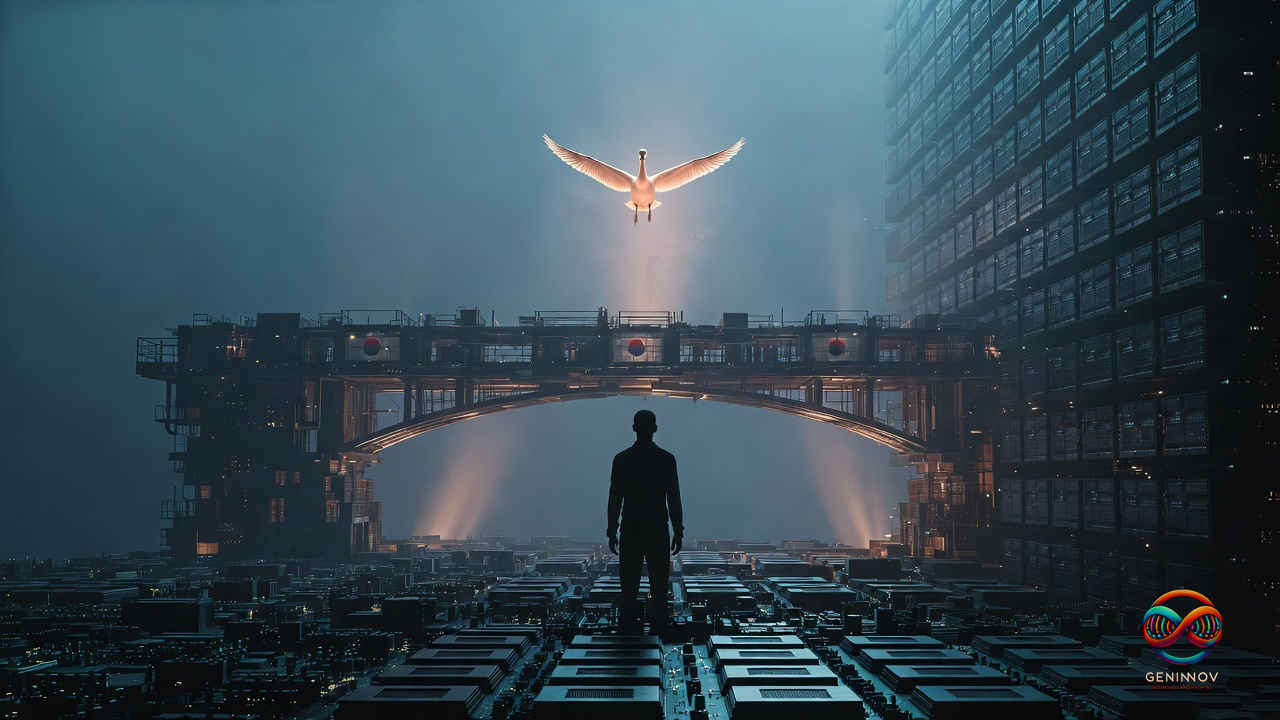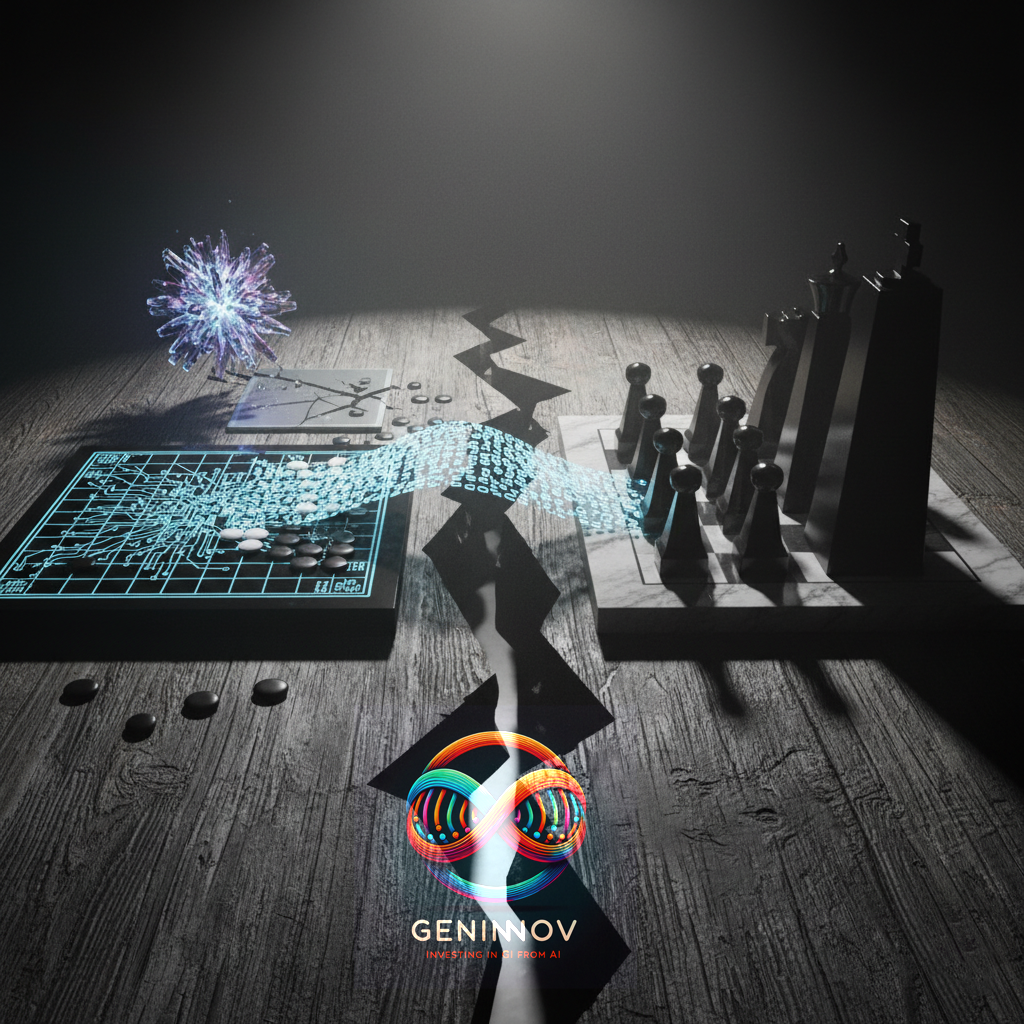The Oracle and the Outlier: A Coincidence of Masters
It was the week of the master and his swansong letter. The investment world held its breath as the Oracle of Omaha penned the last formal letter from the board. Many have begun discussing the transitions at Berkshire, but the news that caught our attention, expectedly, was the organization taking a small position in Alphabet. In a week of volatile price movements, it is a strong reinforcement of our thesis that Google is perhaps the best giant-cap play on generative AI workflows in the business world today. Its spectacular growth, fueled by decades of user habits ingrained across search, email, and productivity applications, positions it uniquely to capture immense value from the current technological wave.
However, the coincidence we want to talk about in this letter is different. The one time we took Mr. Buffett’s name in vain in public was not about Google at all. About a year ago, we wrote an open note suggesting a very different idea for Berkshire’s playbook: Samsung Electronics (“Dear Warren - We Have a Stock for You”). A few kind readers tried to get it in front of people in Omaha and were politely told, quite correctly, that Berkshire does not crowd-source its stock picks. It does its own work. That is exactly why people trust it.
Yet, as the investment world marks the end of one era, a curious synchronicity emerges. Just as Berkshire cements its position in the AI future via Google, different sorts of comments are coming thick and fast from another master: Elon Musk.
To be clear, there are two different types of comments coming from the visionary: one group of comments is around the capacity issues in semiconductor manufacturing, and the reason why Tesla would want to consider getting into the foundry business. The other, completely separately, are compliments and business for Samsung Electronics. This prompts a fascinating, albeit purely speculative, thought: given Mr. Musk’s desired pursuit of supply chain control, and judging only by his public statements regarding Samsung's unique capabilities combined with valuations and Korean Value-Up efforts, could the world’s most demanding chip buyer, or any of the other giants being tortured by foundary and memory issues, be contemplating taking a strategic stake in Samsung Electronics?
The Shifting Power Grid: Where Profit Now Resides
For those who have not yet placed the following giants into the same analytical framework, the numbers can be genuinely astounding. In 2025, TSMC could make almost half as much money as NVIDIA. And, SK Hynix may in turn make over half of TSMC.
This remarkable geometric progression gets more remarkable, particularly for investor minds like ours.This profit ratio, which is a half at each step, is more like a quarter when measured by market capitalization. To be precise, TSMC’s market cap is between a fourth and a third of NVIDIA’s, and SK Hynix’s market cap is less than a quarter of TSMC’s.
Table: Select Giants on Select Parameters (all numbers in USD billions)
.png)
We have included Samsung Electronics in this table, which is the point of the note, but we will return to its unique placement later.
The core numbers reveal a tectonic shift that must be catching the attention of many more than Mr. Musk because of the powers wielded by each one of them. As we covered in our last note on the Real Chip War, all the giants globally are looking for ways to pay less to NVIDIA. And, as we show with a neat table in a previous note, nobody is looking at memories. Something we never explicitly discussed is an even more dire situation in the cutting-edge foundries.
It is quite conceivable that even if the order of profit-making remains the same in the foreseeable future, the profits of NVIDIA, TSMC and SK Hynix are going to move closer toward each other, rather than farther apart. This is driven by accelerating growth rate differences, but more crucially, by the staggering pricing power and capacity constraints now exhibited by the upstream players. It is this concentration of constraint and profitability that must be attracting everyone’s attention, but most notably, that of Elon Musk.
The Terafab Vision: Elon Musk’s Frustration with Capacity
Against that backdrop, we have the following latest developments. At a Tesla meeting in early November, the one where his pay package was approved, Mr. Musk floated the idea of a “Tesla TeraFab”. In his words, Tesla may have to build a chip plant that is “like [TSMC’s] Gigafab but way bigger,” because even the most optimistic supply forecasts from partners are “still not enough” for Tesla’s ambitions. In the matter of days from those comments, Mr. Musk also expressed his frustrations about the slowness of the production speed with “When I asked them how long it would take from groundbreaking to completion of a new chip factory, they told me it would take five years to start production. I felt that five years was an endless wait for me.”
Mr. Musk's frustration is certainly with capacity, but it is impossible to separate capacity from the eye-catching profitability of the businesses he is relying upon.
While Mr. Musk's comments primarily focus on foundry operations, the others are venting frustrations over capacity and cost issues due to memory, the second side of the semiconductor manufacturing field.
Options When Doing Semi-Making Alone is Difficult
Many have enormous faith in what Mr. Musk can do, but even for him, making cutting-edge memory or logic chips will be a monumental, decade-long effort with enormous capex and chances of yield/cost failures. As he has himself noted that building advanced chip manufacturing is “extremely hard… not just build the plant, but the engineering, the science and the artistry.” Separately, he has also remarked about the right talent issues. We concur. We have written about the issues in starting a greenfield in semiconductor manufacturing multiple times in the past. Briefly, setting up a new fab is not merely about buying equipment; it involves accumulating thousands of process innovations over decades. The cumulative, secret-sauce nature of this knowledge makes it effectively impossible for a newcomer to go from zero to cutting-edge without enormous time and capex in the best case.
An aside: it is practical to separate foundries and memory makers in our heads, but in some ways, both are really just different branches of the same brutal craft: semiconductor manufacturing. The tools are similar, the physics is the same, the headaches rhyme. One etches logic, the other stores bits, yet both fight yield problems, defect density, capital cycles, and talent shortages. Those who argue the two are different are 100% right, because the details are different, but it is also important to remember that the problems faced by everyone using chips have many common roots. And, if anyone can promise solutions for both at the same time, it is far, far more valuable.
And, of course, that is Samsung! It is easy to forget that Samsung is the only company on earth that plays both games at scale, sitting just behind TSMC in foundry and just behind SK Hynix in high-end memory. That makes it the only realistic counterweight to two separate monopolies, not just another big brand on your phone screen. Yes, it must also be kept in mind that Samsung is repeatedly ranked Asia’s number one brand for over a decade and brings multiple other strategic positives.
Back to Mr. Musk: What makes the story interesting for Samsung is what he says when he is not threatening to build his own fabs. He has already given Samsung a multi-year chip and module order worth at least US$16.5 billion, centred on its new Taylor, Texas factory. In his words, that figure is “just the bare minimum,” and actual output could be “several times higher.”
He is also unusually complimentary about Samsung’s technology. In October, he remarked that the Samsung fab in Texas has slightly more advanced equipment than TSMC’s fab in Arizona. Claiming TSMC to be inferior in any regard is a comparison few industry insiders make out loud. He has confirmed that Tesla’s next-generation AI chips will be built in both places: slightly different versions at Samsung Taylor and TSMC Arizona.
Put simply: Mr. Musk is both the noisiest critic of capacity and one of Samsung’s most important new customers. He is praising its equipment, wiring billions of dollars of future business through its fabs, and likely also looking at the profits now available in the foundry and memory parts of the chain.
Korea’s Value-Up vs Red Lines
All of this is happening just as Korea itself is changing how it thinks about capital and control. The Value-Up idea has been around for a while, but the new government seems to be far more aware of the issues caused by Korea’s excessively low valuations, aka high cost of equity. Laws are being changed, and corporate structures are being encouraged to focus more on shareholder interests. And, this could not have come at a better time.
Historically, we have seen massive foreign takeovers in the Japanese memory sector. The most famous example is Toshiba Memory (now Kioxia), which saw its lucrative flash memory business sold to a global consortium following financial turmoil. Similar carve-outs of massive Japanese electronics companies have become common over the last two decades.
Nothing similar has ever been successfully attempted in South Korea, with the Lone Star saga often flagged as the biggest warning sign. This is due in part to unique legal and corporate rules governing board structures and shareholder rights, which often act as a strong bulwark against even friendly bids. Some of these rules and attitudes towards outside investments are slowly being reformed. If these reforms are implemented in earnest, the first alliances involving global giants and Korean companies, with the former taking stakes in the latter, cannot be too far away.
It must be noted that nothing in Korea will be easy, particularly in sectors seen as critical for national interests. There is an intense national focus on ensuring that strategically important semiconductor and biotech assets remain firmly under Korean control.
Yet, this protectionism is precisely why a strategic alliance with Samsung is so valuable, and so uniquely compelling for someone like Elon Musk (it does not have to be him). A total takeover is functionally impossible. But a strategic stake—a partnership based on co-investment in new fabrication capacity and guaranteed, long-term supply—is a different proposition entirely. The escalating profits of foundries and memory makers should, in any normal market, be attracting far more attention from global strategic investors in technology. And, this is before anyone looks at valuations.
From Samsung’s viewpoint, they have the potential to take on both TSMC and Hynix in their areas of domination, and they could use more help, given the documented innovation and other management issues of the last few years.
Conclusion: Elon’s Foundry Chatter is Not Going Away
Given the pace at which foundry and memory costs are going up, and capacities that are booked for over a year, the world needs medium-term competitive solutions. The situation is dire and was best captured by an industry expert we talked last year while discussing Samsung’s issues: “It will be a sad world where Samsung fails, and TSMC or Hynix’s edge becomes even greater.”
Those who make an attempt, like the Chinese players today or Mr. Musk or some of the US giants tomorrow, will have mountains to climb for years. And in every such attempt, the best partner to consider, if it is open to such a partnership, appears to be Samsung Electronics.
To be clear, everything discussed in the note is speculation, not prediction. We have no special insight into Mr. Musk’s plans or Samsung’s boardroom. The point is more general. As foundry and memory profits keep rising, and as the cost of building the next generation of fabs climbs into the tens of billions, it is hard to believe that strategic investors will stay on the sidelines forever.



